The future of virtual reality (VR) is poised for transformative growth, with businesses increasingly adopting VR for remote collaboration, training, and immersive retail experiences. As industries like healthcare and education integrate VR technologies, innovations driven by advancements in hardware, artificial intelligence, and 5G are enhancing user experiences and operational efficiency. This evolution highlights the potential of VR to address specific challenges and redefine engagement across various sectors.
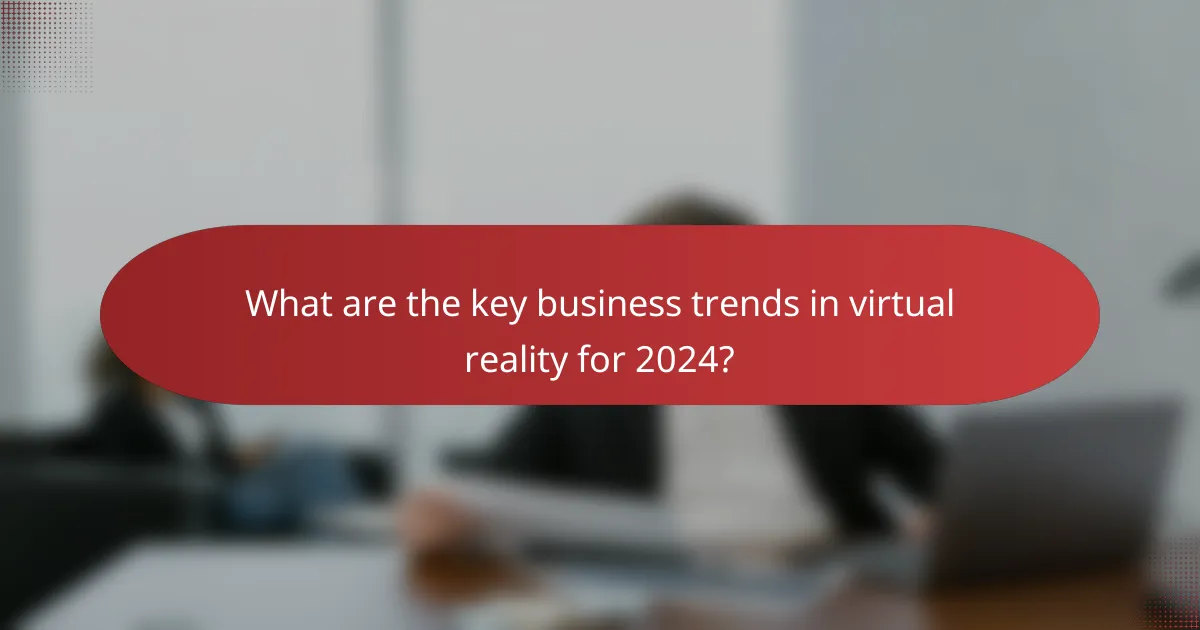
What are the key business trends in virtual reality for 2024?
In 2024, key business trends in virtual reality (VR) include increased adoption for remote collaboration, growth in VR training programs, and the expansion of VR in retail experiences. These trends reflect the evolving landscape of how businesses leverage VR technology to enhance productivity, training effectiveness, and customer engagement.
Increased adoption in remote collaboration
Remote collaboration using virtual reality is gaining traction as businesses seek to enhance communication and teamwork among distributed teams. VR platforms allow users to interact in immersive environments, making meetings and brainstorming sessions more engaging and productive.
Companies are investing in VR tools that facilitate real-time collaboration, enabling participants to share documents, 3D models, and other resources seamlessly. This trend is particularly beneficial for industries such as architecture, engineering, and design, where visual representation is crucial.
Growth in VR training programs
VR training programs are becoming increasingly popular as organizations recognize the effectiveness of immersive learning experiences. These programs provide employees with hands-on training in a safe environment, reducing the risks associated with real-world training scenarios.
Industries such as healthcare, manufacturing, and aviation are particularly leveraging VR for training purposes. For example, medical professionals can practice surgical procedures in a virtual setting, while factory workers can simulate machinery operation without the associated hazards.
Expansion of VR in retail experiences
Retailers are exploring virtual reality to enhance customer experiences and drive sales. VR allows customers to visualize products in their own space or try on clothing virtually, providing a unique shopping experience that can lead to higher conversion rates.
Brands are increasingly investing in VR showrooms and interactive advertisements that engage customers in innovative ways. This trend not only improves customer satisfaction but also helps retailers gather valuable data on consumer preferences and behaviors.
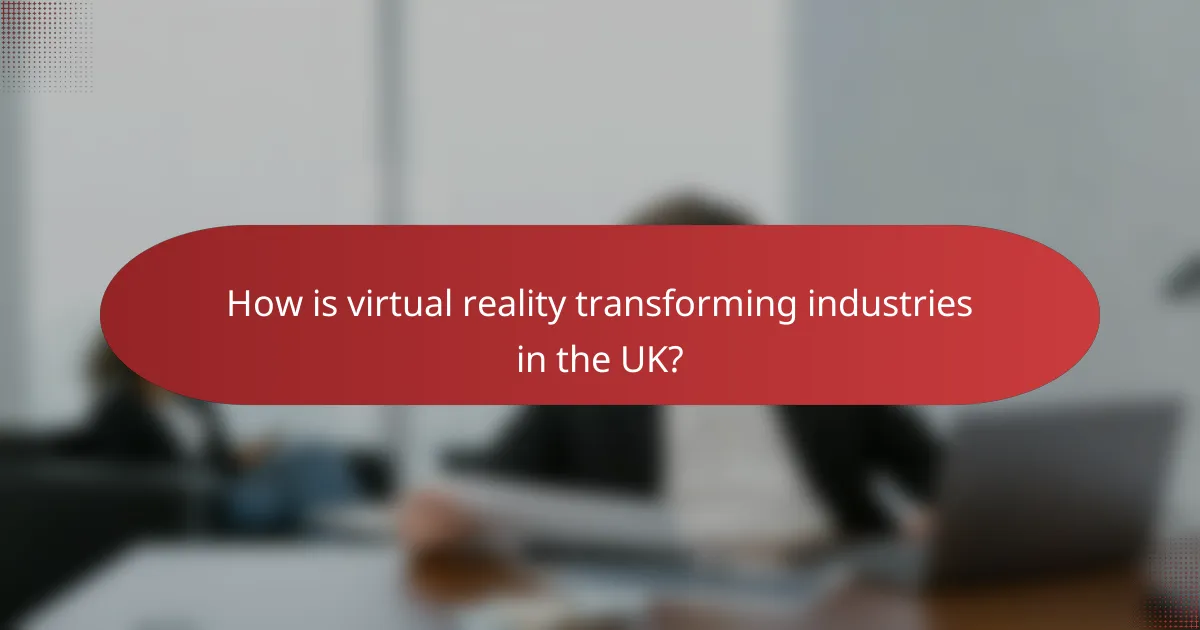
How is virtual reality transforming industries in the UK?
Virtual reality (VR) is significantly reshaping various industries in the UK by enhancing user experiences and improving operational efficiency. From healthcare to education, VR technologies are being integrated to provide innovative solutions that address specific industry challenges.
Healthcare applications for patient treatment
In the UK, VR is revolutionizing healthcare by offering immersive therapies for conditions such as anxiety, PTSD, and phobias. Patients can engage in controlled environments that simulate real-life situations, allowing them to confront fears safely and effectively.
Additionally, VR is being used for surgical training, enabling medical professionals to practice procedures in a risk-free setting. This hands-on experience can lead to improved skills and better patient outcomes.
Real estate virtual tours
Virtual reality is transforming the real estate market in the UK by providing potential buyers with immersive property tours from the comfort of their homes. This technology allows users to explore properties in detail, making it easier to assess their suitability without the need for physical visits.
Real estate agents can leverage VR to showcase multiple properties efficiently, saving time and resources. This trend is particularly beneficial in urban areas where travel times can be significant.
VR in education for immersive learning
In the UK education sector, VR is enhancing learning experiences by providing students with immersive environments that facilitate deeper understanding of complex subjects. For instance, history students can virtually visit ancient civilizations, while science students can explore the human body in 3D.
Schools and universities are increasingly adopting VR tools to engage students and cater to diverse learning styles. This approach not only makes learning more interactive but also helps in retaining information more effectively.
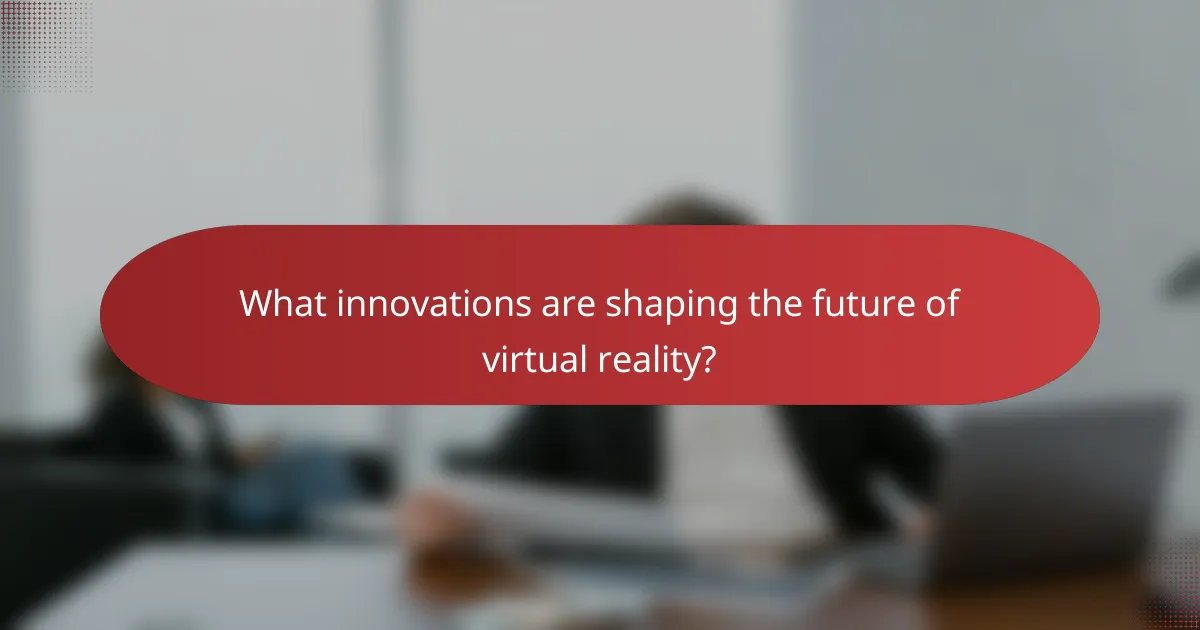
What innovations are shaping the future of virtual reality?
Innovations in virtual reality (VR) are primarily driven by advancements in hardware, the integration of artificial intelligence (AI), and the rollout of 5G technology. These developments enhance user experiences, improve accessibility, and expand the potential applications of VR across various industries.
Advancements in VR hardware technology
Recent advancements in VR hardware technology include lighter headsets with improved resolution and field of view. Companies are focusing on creating wireless devices that offer greater mobility and comfort, which enhances the immersive experience.
For instance, the latest VR headsets feature high refresh rates and low latency, reducing motion sickness and improving user engagement. Additionally, advancements in haptic feedback technology allow users to feel sensations in virtual environments, making experiences more realistic.
Integration of AI in VR experiences
The integration of AI in VR experiences is revolutionizing how users interact with virtual environments. AI algorithms can analyze user behavior in real-time, adapting scenarios and challenges to suit individual preferences and skill levels.
For example, AI-driven NPCs (non-player characters) can provide more realistic interactions, enhancing storytelling and gameplay. This personalization not only improves user satisfaction but also increases the educational potential of VR applications in training and simulations.
Development of 5G for enhanced connectivity
The development of 5G technology is crucial for enhancing connectivity in VR applications. With significantly lower latency and higher bandwidth, 5G allows for seamless streaming of high-quality VR content, making remote experiences more viable.
As 5G networks expand, users can expect smoother multiplayer experiences and more complex virtual environments that require real-time data processing. This connectivity will enable industries such as gaming, healthcare, and education to leverage VR more effectively, creating opportunities for innovative applications.
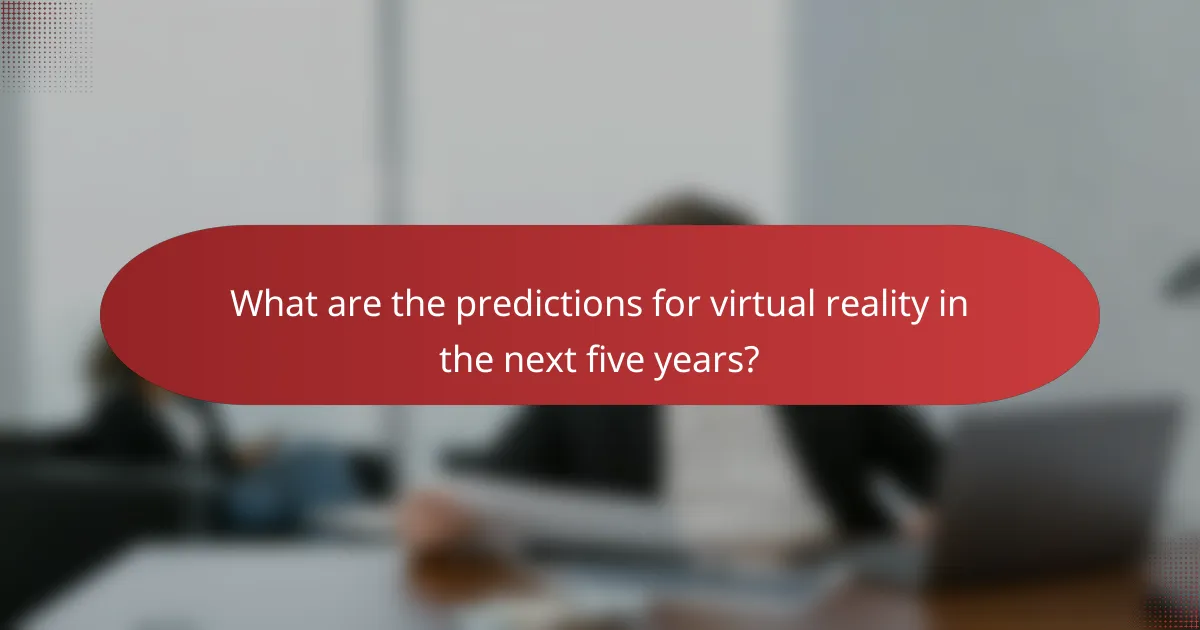
What are the predictions for virtual reality in the next five years?
In the next five years, virtual reality (VR) is expected to become integral to various industries, enhancing both business operations and consumer experiences. Innovations in technology and increased accessibility will drive widespread adoption, making VR a standard tool for engagement and collaboration.
Widespread use in everyday business operations
Businesses are predicted to incorporate VR into their daily operations for training, remote collaboration, and product design. For instance, companies may use VR simulations to train employees in a safe environment, reducing costs and risks associated with traditional training methods.
Moreover, VR can facilitate virtual meetings, allowing teams to collaborate in immersive environments regardless of their physical locations. This shift could lead to significant reductions in travel expenses and time, making operations more efficient.
Increased consumer engagement through VR marketing
VR marketing is set to revolutionize how brands interact with consumers, offering immersive experiences that traditional advertising cannot match. For example, companies might create virtual showrooms where customers can explore products in a 3D space before making a purchase.
This level of engagement can lead to higher conversion rates, as consumers are more likely to remember and connect with brands that provide interactive experiences. Brands that invest in VR marketing strategies may see a competitive edge in capturing consumer attention.
Emergence of VR social platforms
The next few years will likely see the rise of VR social platforms, where users can interact in virtual spaces. These platforms may enable more meaningful connections, allowing users to attend events, socialize, or collaborate on projects in a shared virtual environment.
As these platforms develop, they may also integrate features like virtual commerce, enabling users to purchase goods and services directly within the VR space. This evolution could create new revenue streams for businesses and redefine social interaction in the digital age.
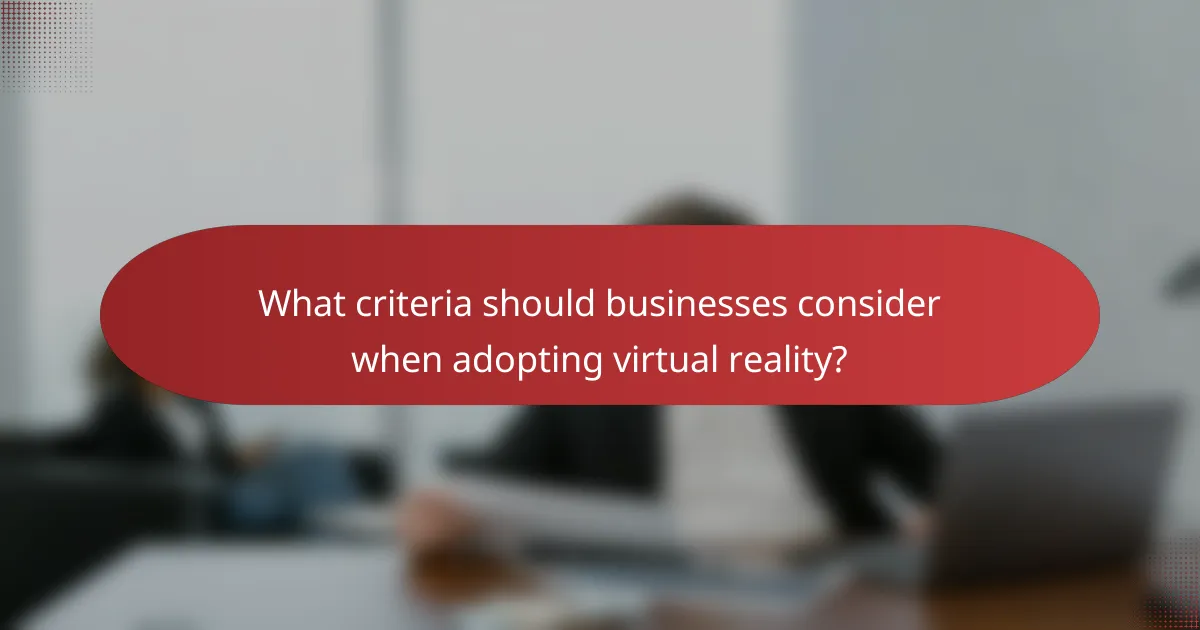
What criteria should businesses consider when adopting virtual reality?
Businesses should evaluate cost, compatibility, and user experience when adopting virtual reality (VR). These criteria help ensure that VR solutions align with organizational goals and provide a positive return on investment.
Cost-effectiveness of VR solutions
Cost-effectiveness is crucial when considering VR solutions. Businesses should analyze both initial investment and ongoing expenses, including hardware, software, and maintenance costs. A well-planned budget can help identify options that provide the best value without compromising quality.
For example, small to medium enterprises may find affordable VR options starting from a few hundred to a few thousand USD, depending on the complexity of the solution. It’s essential to weigh these costs against potential benefits, such as increased training efficiency or enhanced customer engagement.
Compatibility with existing systems
Ensuring compatibility with existing systems is vital for a smooth VR integration. Businesses should assess how new VR tools will interact with current software and hardware. This includes checking for necessary updates or additional investments in infrastructure.
For instance, if a company uses specific customer relationship management (CRM) software, it should confirm that the chosen VR solution can seamlessly integrate with it. This reduces the risk of operational disruptions and enhances overall productivity.
User experience and accessibility
User experience and accessibility are key factors in the successful adoption of VR. Solutions should be intuitive and easy to navigate, catering to a diverse user base. Businesses should consider how different users will interact with the technology, including those with disabilities.
Conducting user testing can provide valuable insights into how well the VR solution meets user needs. Additionally, providing training and support can enhance user engagement, ensuring that employees or customers can fully benefit from the VR experience.
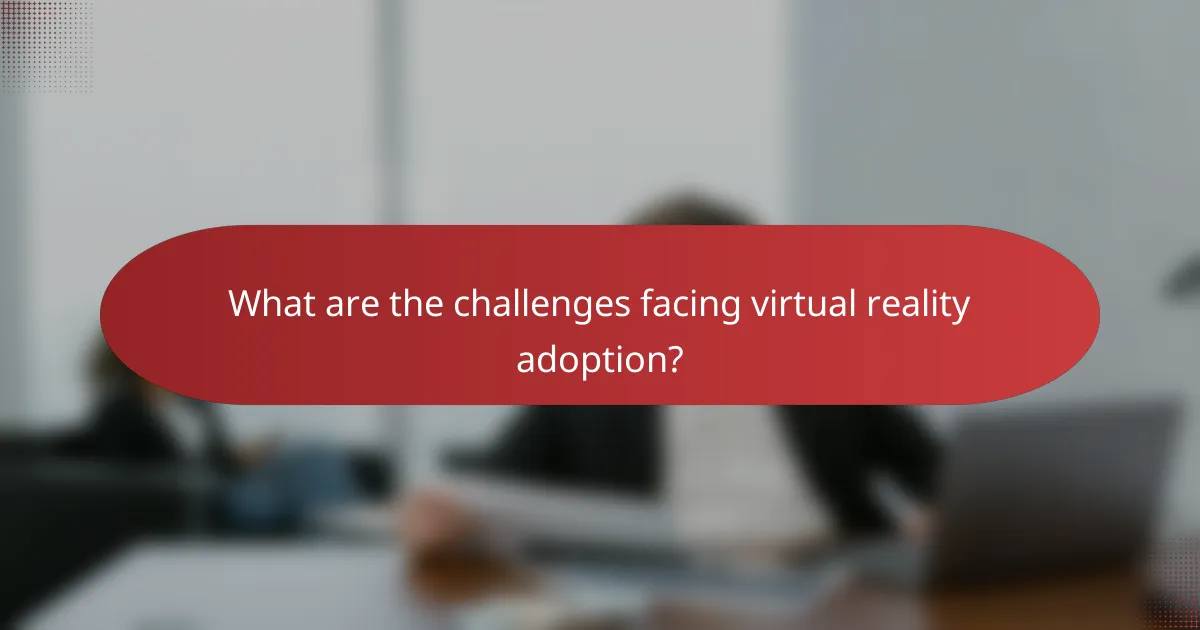
What are the challenges facing virtual reality adoption?
Virtual reality (VR) adoption faces several significant challenges that can hinder its widespread use in various sectors. Key obstacles include high initial investment costs, technical limitations, and the need for user training to effectively utilize VR technology.
High initial investment costs
The financial barrier to entry for VR can be substantial, often requiring investments in hardware, software, and infrastructure. High-quality VR headsets can range from a few hundred to several thousand USD, depending on the specifications and capabilities required for specific applications.
Businesses must also consider ongoing costs such as software licensing, maintenance, and potential upgrades. For organizations looking to implement VR solutions, it is crucial to conduct a cost-benefit analysis to determine the return on investment and identify funding options, such as grants or partnerships.
Technical limitations and user training
Technical limitations, such as latency issues and the need for powerful computing resources, can affect the user experience in VR. Users may encounter motion sickness or discomfort if the technology does not perform optimally, which can deter adoption.
Additionally, proper user training is essential to maximize the benefits of VR. Organizations should invest in comprehensive training programs to ensure users are comfortable with the technology and understand its applications. This may include hands-on workshops, tutorials, and ongoing support to address any challenges that arise during usage.


